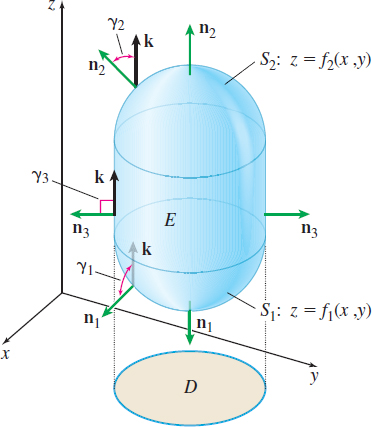EXAMPLE 5Finding the k Component of the Outer Unit Normal Vectors of an xy-Simple Surface
Consider the surface S with positive orientation that forms the boundary of the closed, bounded solid E shown in Figure 61. Notice that the surface S can be decomposed into three surfaces, S1, S2, and S3, and that each of the outer unit normal vectors n1, n2, and n3 of the three surfaces points away from the solid E enclosed by S.
Assume the surfaces S1 and S2 are defined by the equations S1:z=f1(x,y)andS2:z=f2(x,y)
where f1(x,y)<f2(x,y) on D, the functions f1 and f2 are continuous on D, and both f1 and f2 have continuous partial derivatives on D. The surface S3 is the portion of a cylindrical surface between S1 and S2 formed by lines parallel to the z-axis and along the boundary of D. The solid E is enclosed by S2 on the top, S1 on the bottom, and the lateral surface S3 on the sides. A surface S with these properties is called \boldsymbol x\boldsymbol y-simple.
Find the \mathbf{k} component of the outer unit normal vectors of S.
Solution For the top surface S_{2}: z=f_{2}(x,y), the outer unit normal vector \mathbf{n}_{2} is the same as the upward-pointing unit normal vector to S_{2}. \begin{equation*} \mathbf{n}_{2}=\dfrac{-(f_{2})_x(x,y)\mathbf{i}-(f_{2})_ y(x,y)\mathbf{j}+\mathbf{k} }{\sqrt{[(f_{2})_x(x,y)]^{2}+[(f_{2})_y(x,y)]^{2}+1}} \end{equation*}
Direction cosines of a vector in space are discussed in Section 10.4, pp. 718-719.
The \mathbf{k} component of \mathbf{n}_{2} is given by the direction cosine \cos \gamma _{2}, where \cos \gamma _{2}=\mathbf{n}_{2}\,{\cdot}\, \mathbf{k}=\dfrac{1}{\sqrt{ [(f_{2})_x(x,y)]^{2}+[(f_{2})_y(x,y)]^{2}+1}}
1033
For the bottom surface S_{1}: z=f_{1}(x,y), the outer unit normal vector \mathbf{n}_{1} equals the downward-pointing unit normal vector -\mathbf{n} to S_{1}. \begin{equation*} \mathbf{n}_{1}=-\mathbf{n}=\dfrac{(f_{1})_{x}(x,y)\mathbf{i}+(f_{1})_y(x,y)\mathbf{j}- \mathbf{k}}{\sqrt{[(f_{1})_x(x,y)]^{2}+[(f_{1})_y(x,y)]^{2}+1}} \end{equation*}
The \mathbf{k} component of \mathbf{n}_{1} is given by the direction cosine \cos \gamma _{1}, where \cos \gamma _{1}=\mathbf{n}_{1}\,{\cdot}\, \mathbf{k}=\dfrac{-1}{\sqrt{[(f_{1})_x(x,y)]^{2}+[(f_{1})_y(x,y)]^{2}+1}}
For the lateral surface S_{3}, the outer unit normal vector \mathbf{n} _{3} is orthogonal to \mathbf{k} at each point on S_{3}. The \mathbf{k } component of \mathbf{n}_{3}, given by the direction cosine, \cos \gamma _{3}, is therefore 0.
